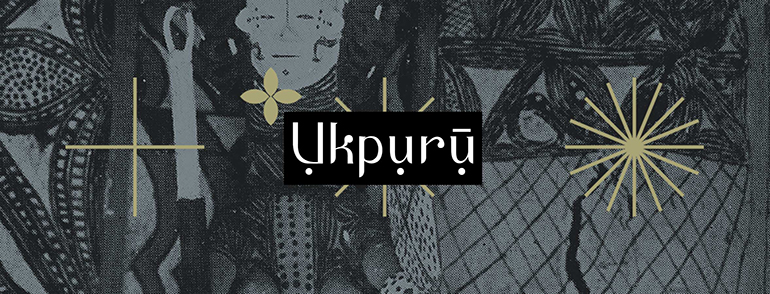 Objects of the shrine of Yọ́k Òbòlò of the Andoni, Agwut Obolo, present-day Rivers State. By A. A. Whitehouse who led a raid on the shrine, 1904. British Museum.
Objects of the shrine of Yọ́k Òbòlò of the Andoni, Agwut Obolo, present-day Rivers State. By A. A. Whitehouse who led a raid on the shrine, 1904. British Museum.
Andoni was difficult for missionaries to penetrate. Yọ́k Òbòlò was condemned by figures like Ajayi Crowther, who led the destruction of its offshoots in Bonny, for its role in the resistance to Christianity in the area, especially in the case of Jaja of Opobo who was in dispute with Crowther and Christian missions.
 Bronze and copper sword from Alama, also known as Alabie, known as Allabia to Europeans, Agwut Obolo. Looted by Whitehouse and company from the shrine of Yọ́k Òbòlò. Now at the British Museum. Photo: British Museum.
Bronze and copper sword from Alama, also known as Alabie, known as Allabia to Europeans, Agwut Obolo. Looted by Whitehouse and company from the shrine of Yọ́k Òbòlò. Now at the British Museum. Photo: British Museum.
King Jaja was given land by the Andoni in 1869 to found Opobo with the condition that he venerated Yọ́k Òbòlò in the form of objects given to the divinity annually, a requirement of all under the influence of the divinity. The king also wore a ritual necklace of the divinity.
Traditional religion underpinned autonomy and inspired resistance while Christianity was used as pacification. This gave rise to the colonial regime's policy of destroying shrines and major oracles.
 Bronze leopard skull from the shrine of Yọ́k Òbòlò, Alama, also known as Alabie, Agwut Obolo. Photo: British Museum.
Bronze leopard skull from the shrine of Yọ́k Òbòlò, Alama, also known as Alabie, Agwut Obolo. Photo: British Museum.
The shrine of Yọ́k Òbòlò housed sacred bronze and ivory objects as well as the skulls of the adversaries of the Andoni, this was how it came to be known as the 'House of Skulls'.
Bronze seated figure from the shrine of Yọ́k Òbòlò, Alama, also known as Alabie, Agwut Obolo. Photo: British Museum.Yọ́k Òbòlò is the tutelary war and justice divinity of the Andoni. Later a collective of multiple divinities, Yọ́k Òbòlò is regarded as a king of the Andoni, a deified soldier, and, traditionally, the Andoni regard themselves as the followers of Yọ́k Òbòlò. Already active before the 18th century, Yọ́k Òbòlò was thought to forbid the Andoni from starting wars, but sanctioned punitive actions against the Andoni's aggressors. Yọ́k Òbòlò also forbade civil wars in Andoni or the killing of Andoni by other Andoni, punishable by impalement.
The bronzes in the shrine of Yọ́k Òbòlò are of unknown origin, believed by some scholars to be the work of itinerary smiths, placed within the class of bronze sculptures studied collectively under the title of the Lower Niger Bronze Industry.
 Copper object (manilla?) from the shrine of Yọ́k Òbòlò, Alama, also known as Alabie, Agwut Obolo. Photo: British Museum.
Copper object (manilla?) from the shrine of Yọ́k Òbòlò, Alama, also known as Alabie, Agwut Obolo. Photo: British Museum.
Although officially ‘destroyed’ by the British in 1904, and many of the bronze shrine pieces looted and now in the British Museum and National Museums Scotland, like many major shrines and oracles ‘destroyed', it was merely moved or reinstated shortly after. The influence of Yọ́k Òbòlò continues. A drum sacred to the shrine was not captured by the British. Later Christian missionaries were more affective in diminishing African spiritual autonomy.
Sources: Nkparom C. Ejituwu (1995); Monday B. Abasiattai (1990); Joseph Miles Davey (2015).

No comments:
Post a Comment